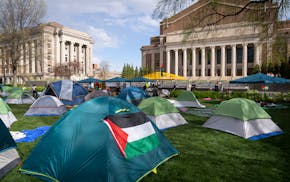They're the embodiment of the well-known African proverb "it takes a village to raise a child."
In St. Paul and Minneapolis, encouraging efforts are underway to turn two 250-block areas into the kind of supportive villages kids need to succeed in school.
Leaders in St. Paul are focusing on a 250-block area of the Frogtown and Summit-University neighborhoods, home to 22,000 residents and two of the city's most-challenged elementary schools -- Jackson and Maxfield.
A coalition of schools, government, community nonprofits and foundations have come together to plan the St. Paul effort under the banner "Promise Neighborhood." The Amherst H. Wilder Foundation is leading the planning, and foundations have already contributed $160,000 toward its cost.
In Minneapolis, a similar effort began nearly two years ago. Called the Northside Achievement Zone, the 255-block swath of the near North Side is the focus of a coalition of 60 groups working on improving schools and neighborhoods.
Led by the PEACE foundation, NAZ uses an "all hands on deck" strategy to ensure that kids and their families get what they need. The idea is that successful families and communities will produce healthy, successful students.
By the end of the summer, NAZ expects to sign up 200 families in the zone to work with "connectors" who will help them navigate the system and work with partner groups to get services in areas such as housing, health care, employment counseling and prenatal care -- all focused on helping kids learn.
Both city efforts are modeled after the acclaimed Harlem Children's Zone in New York City. During the past decade, founder Geoffrey Canada has dramatically improved student achievement in a 97-block area of Harlem by supporting kids and families from before birth to college.
Both city coordinating groups are applying for $500,000 to $750,000 Promise Neighborhood grants from the federal Department of Education. The Obama administration is making $10 million available to as many as 20 organizations for planning. About 340 groups nationwide have applied.
But even if the core city efforts don't receive the federal funding, they wisely plan to move ahead with coordinating services to support student learning.
The new core city programs are certainly not the first time local leaders have tried a holistic approach to serving lower-income kids. In the 1990s, the switch from a state education department to a state Department of Children, Families and Learning was designed to coordinate efforts across agencies on behalf of children.
In addition, many community-based heath clinics and other social-service agencies work with struggling families to address issues ranging from employment to housing and health to education.
But spurred on by the recent success of the Harlem Zone and similar programs, momentum has built to support education initiatives that work. The new local efforts hold great promise to narrow the persistent learning disparity between low-income students and their more affluent peers.
Store guns safely and save lives

Why we protested at the University of Minnesota


